Gunther Animation: Part 2
I decided to redraw my entire animation the week before it was due, because I wasn’t happy with the original one. Sleep is overrated anyways.
Illustration
I decided to redraw my entire animation the week before it was due, because I wasn’t happy with the original one. Sleep is overrated anyways.
Frances Ross
Seminar 4D
Andrew John Milne’s Modern Praxinioscope
The praxinoscope of the late 1800’s is an archaic example of early motion graphics. Made by placing two cylinders inside of each other— the outer one having a succession of still images, and the inner circle containing mirrors—when spun, an illusion of movement was created by the images projection onto the inner mirrors and by our own retinal persistence of vision.
Andrew John Milne’s reinvented Praxinoscope is a swirling mass of lights and wood suspended from the ceiling. His piece, entitled, Apparatus 9, is a bulbous cylindrical orb composed of a wooden checkerboard pattern of square panels and windows, paper, mirrors, lights, and a motor. Its etherial quality is only reinforced by its “autonomous” motorized movement.
When gazing inside Apparatus 9, one first sees only the wooden skeletal framework of the piece as it flickers past. With a closer inspection into the windows, the viewer is able to see a ghostly image of a walking nude female. The image is projected along a vertical axis as well, which gives the appearance of holography and perspective.
What makes this piece effective is the apparent “wow” factor. Apparatus is a giant spinning orb, that basically begs to be looked at and looked into. There is also a sense of wonder that comes from looking into this archaic object: This work is strictly analog, despite the digital-like precision of the moving images, which shows off a level of craftsmanship and attention to detail. My only criticism is that I wish that the entire piece was on a larger scale, although it’s size perhaps adds to the sense of intimacy with the viewer.
The concept behind Apparatus is an exploration of autonomous technology and how we relate to it, especially regarding digital technology. In this analog piece, we are given a view of an almost Digital view of a the moving figure, and although the viewer perceives it as a seamless, there is a a flicker of malfunction which creates an Uncanny Valley. The figure is naked and idyllic like Eve in the garden of Eden, but she looks robotic and detached. Milne is trying to make a statement on digital technology. IN a review of Milne’s Apparatus, Tom Kohut writes, “ruination is encoded in the apparatus, that the dematerialization….in the present digital situation leads inexorably to disappearance.”
Apparatus 9:



Apparatus 9 in motion:



All images are taken from http://andrewjohnmilne.com/apparatus/
and http://andrewjohnmilne.com/project/apparatus-9-holographic-praxinoscope/
This is my first attempt at animation. Gunther the Dinosaur makes another appearance in my work (he’s so cute that he really just lends himself to drama). The assignment guidelines were: A character enters a space, encounters a problem, and solves the problem.
Made using index cards, shot with Dragonframe, and edited with Photoshop.
Gunther: Part 1 from FrancesAlbatross on Vimeo.
Ukiyo-E inspired triptych for Core Studio 2D
In creating this piece, I wanted to stay true to the inking style of Ukiyo-E: minimal linework, no shading, ornate robes, and minimalist expressions. By varying line weight I was able to accomplish subtle shading to hint at light and dark areas. For inking I used a Pentel Brush Pen and a Copic Fineliner
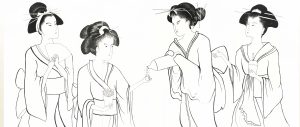
Ink lines for Ukiyo-E Americana
After scanning my images I used Photoshop to add color and texture. Starting with a cream colored overlay allowed for a softer tone to the entire piece overall. Selective erasing was then used to bring back some areas of white ie. the skin and eyes. I wanted the 4 figures to look mostly the same, using only their Kimono style and hairstyles as the dominant distinguishing features. Each figure is branded with a stereotypical American thing: the American flag, McDonalds, Coca-Cola, and Starbucks. For texture, I created custom brushed with brand logos. As a finishing texture, I overlayed a woodgrain photo over the entire image and turned down the opacity. This created a subtle texture to mimic that of old parchment paper or scrolls.
The final piece: Four Courtesans at a gathering place (in this case, a silhouetted shopping mall), engaging in stereotypical American food and drink. I used the vivid coloring of traditional Japanese Kimonos as inspiration, but applied a stereotypically American color scheme to go with each figures respective brand. By inserting American iconography into a traditional Japanese art form, I wanted to show how America bastardizes the traditions and customs of other cultures.
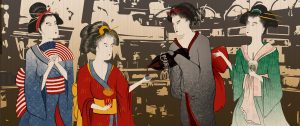
Ukiyo-E Americana by F.A. Ross
Frances Ross
Objects as History Fall 2017
(From left to right: King Tut, Artemidorus, Napoleon Bonaparte, and Nick Reynolds Mask of John Joe Amador)
How the meanings of Death masks has followed our shifts in cultural attitudes towards death
The cemetery by my Brooklyn apartment is a sprawling 478 acres, filled with 19th- and 20th-century statues and mausoleums that mark the remains of generals, artists, and NYC elites. On early mornings to school, I pass by this quiet sanctuary, in stark contrast to the busy street full of frenzied cars and pigeons and people. It’s autumn, so there’s a canopy of orange and brown leaves on the grass that pillows the bouquets of pink carnations and red roses, while the obelisk obsidian and cement markers jut towards the grey sky. Greenwood cemetery is home to 600,000 graves–roughly a quarter of Brooklyn’s living population.
Modern American culture has a strange relationship with death. We commit murder in video games, joke about the zombie apocalypse, and make light of the constant threat of world destruction with gallows humor. Death is glamorous and sensationalized in a way that only Hollywood could impregnate our brains with. Yet most people don’t encounter real death on a regular basis. We maintain a safe disconnect rather than acknowledge it.
Throughout history Death masks were one way to acknowledge, and even honor death. Death masks have had many transformations over time. At it’s core, it is a mask worn for burial. The variations in death masks have often been determined by access to, or abundance of, resources: wood, gold, plaster, and polyurethane have all been used. Some masks, like those of King Tut and Artemidorus, are stylized based on the cultures artistic aesthetic. The Masks of Napoleon Bonaparte and John Joe Amador, are actual molds of their heads, removing any artistic interpretation, and portraying the brutal honesty of their inanimate features. Why people have made death masks has changed over time though. Once ritualistic, the modern disconnect towards death has objectified these sacred objects. Through analyzing the masks of King Tut, Artemidorus, Napoleon Bonaparte, and Nick Reynolds death mask of John Joe Amador, I will show how the shifting meanings of the the death mask has followed our cultural attitudes towards death.
Egyptians view of death was not as an end, but as a cycle. “ Ancient Egyptians, from their narrow river valley, observed the constant regeneration of the land through yearly floods. They could easily believe that such regeneration would be granted to human beings, or at least to their rulers, who became gods on earth.” Egyptians believed that material wealth followed a person into the afterlife. Making a death mask for people of importance, was a ritualistic part of burial. It was believed that without a face, the soul would not recognize the body in the afterlife.
King Tut’s Death Mask is iconic. In the style of Ancient Egyptian art, Tut’s gilded face has a stoic gaze with heavily lined eyes and brows. His mask is ornamented with lapis lazuli and glass. The yellow gold, creates a bold display of primary colors with the semiprecious stone inlays. His striped headdress and beard are symbols of his power as Pharaoh, while the mask itself is covered with protective spells from the Book of the Dead. More religious symbolism can be seen in the placement of the goddesses Nekhbet and Wadjet on his headress, and the falcon heads at either end of his collar. The extravagance of his mask shows both his importance in life, as well as his culture’s beliefs of the afterlife.
The Egyptian burial practice of masks and mummification did not end with the fall of their Empire. Trade and war brought the Egypt and Rome together by the year 30 BCE, and the Romans adopted their own interpretation of Egyptian burial practices: Fayum Mummy portraits. In an article written for the Guardian, journalist Jonathan Jones describes the portraits as “A synthesis of Egyptian and Greco-Roman art.” This shifting attitude towards realistic representation of the dead began to emerge with the Romans. The Mummy of Artemidorus is an excellent example of how cultural death rituals blend and change throughout history. Around 100-120 AD, Artemidorus’ body was mummified in the traditional Egyptian style. Iconography from Egyptian religion can be found on the body of Artemidorus: Jones continues, “This mummy is decorated with symbols of Egyptian magic to transport the dead into the afterlife; below the portrait is a gold leaf vignette of the god Anubis attending the mummy; in another Osiris rises from his bier. This portrait is the face Artemidorus took with him into the afterlife.”
Unlike Egyptian Burial masks, the Romans aesthetic can be seen on the painted limewood panel covering the face. Romans use careful rendering of light and shadow create a three dimensional effect with wax-based pigments, rather than the Egyptian style of sculptural masks. The Romans did take some artistic liberties though. “…while the portraits are idealised, they bear a basic resemblance to the deceased,” says Jones.
Although death masks faded as a practice after the fall of the Roman Empire, they made a comeback in 1700’s Europe. These modern European death masks, however, were less concerned with spiritual immortality than historical immortality. After the Enlightenment Era, much of Europe became interested in documentation and realism, and these masks were intended as accurate records of physical appearance, usually of the famous and/or wealthy.
Between the 1700’s and the 1800’s, some of the most notable masks were those of King Louis IV in 1793 (200 years after his death), Napoleon Bonaparte in 1821, and Beethoven in 1827. Napoleon’s mask in particular became widely distributed as a collectible. The Victorians close relationship with death likely contributed to the popularity of these masks. D. Lyn Hunter explains in her article A Victorian Obsession with Death, “‘Death was a common domestic fact of life for Victorians…so they developed elaborate rituals to deal with it.’” Napoleon’s mask marked a further cultural detachment from death. Gone were the religious iconography, the elaborate burial rituals, and the artistic extravagance. The Style of Napoleon’s mask marked an era of honest representation. Napoleon is not glamorized in his mask– It’s a plaster mold of his actual face. He is expressionlessly dreamy, with eyes closed. There’s no color, golden accents or precious stone inlays–only a simple, somber mask.
With the rise of representational death masks, began the rise of marketing. The story behind the making of Napoleon’s death mask is almost more interesting than the mask itself. According to a 2016 Mental Floss article, “The circumstances behind the casting of Napoleon Bonaparte’s death mask are murky, to put it mildly….a mold was cast by English surgeon Francis Burton and/or Napoleon’s Corsican doctor Francesco Antommarchi….The mold was taken in at least two sections: the face, and the back of the head, ears, and pate.
Napoleon’s attendant Madame Bertrand made off with the face cast, leaving Burton with the back mold, which was less than useful without a face to go with it. He sued her to no avail. She returned to France and started making copies, one of which she gave to Antommarchi. Then he started making copies, and he traveled a lot, so pretty soon there were copies of Napoleon’s earless face from New Orleans to London. They sold like hotcakes.”
The detached memorialization of the dead for purely documentational reasons is a trend that continued through the 20th century. Death masks were still mostly reserved for people of some importance though. The masks of political figures such as Vladimir Lenin (1924) and Heinrich Himmler (1945) were made during this time. The 21st century however, marked a shift in the narratives surrounding death masks. Artist Nick Reynolds creates a modern interpretation. In a 2017 BBC interview, he says, “It’s a way of cheating death I suppose, and it’s a form of immortality.” Reynolds has made death masks many people, most notably American inventor William Kelly, Sex Pistols Band Manager Malcolm McLaren, and even his own father—criminal Bruce Reynolds.
The influence of earlier death masks throughout history can be seen in his work. His masks draw inspiration from the Victorian style of plaster face casts. His modern take: A powerful narrative combined with Polyurethane resin and metal powder. His masks give off the metallic look of cast bronze. In addition, with his masks, he walks the fine line between honoring the dead and objectifying them. Reynolds work ranges from memorial masks of everyday people, to inmates, to cultural icons. Perhaps what is most striking is the way he gives faces to people who are ignored, as in the case of Texas inmate John Joe Amador. His mask of Amador is an object of profound social commentary. Since the reinstitution of the death penalty in 1982, Amador was the 402nd person to be executed.
The narrative nature of Reynolds masks forces us to confront death as a society, rather than turning away from it. As in the case of Amador’s mask, Reynolds challenges our ideas of memorialization. Amador was an inmate–not an icon of historical importance, and definitely not someone that might be deemed “worthy” of being honored. He was however, someone who likely fell victim to the racism and classism inherent in the judicial system. His speculated innocence and his wrongful death sentance has transformed his death mask from a memorial object to a symbol. Over a phone conversation with Reynolds before his death, Amador said, “Having a death mask made was a real honour because it was something normally reserved for kings and people like that….”
Death masks provide an important clue about a society’s relationship with death. As seen in the Masks of King Tut, Artemidorus, Napoleon, and Amador, there is the common thread of memorialization and preservation, with the former two containing heavy religious associations. The 19th century and present day masks of Napoleon and Amador mark a shift from ritualistic practices in lieu of accurate documentation. The shift from sacred to objectification is something that persists in current culture. Museums are a great example. I love museums, yet I now wonder if the public display of a these private death masks distorts the meaning for their original creation. Does it bring us closer to understanding death, or fuel our distance from it? For me, Putting a face to death humanizes it in a tangible way. The allure of Reynolds death masks is the way that he forces the viewer to confront not only death, but the accepted norms of a diseased society. Being sentient means being burdened with the thought of our own mortality. The transformative attributes of death masks signals that our relationship with death, though estranged, is still one of curiosity and respect.
Bibliography
“7 Famous Death Masks That Had Lives of Their Own.” Mental Floss, 14 Mar. 2016, mentalfloss.com/article/76672/7-famous-death-masks-had-lives-their-own. Interesting historical figures immortalized with face masks
“About / History.” Green-Wood, http://www.green-wood.com/about-history/. Information regarding Brooklyn’s Greenwood Cemetary
Campbell, Duncan. “Duncan Campbell on death mask sculptor Nick Reynolds.” The Guardian, Guardian News and Media, 27 Sept. 2007, http://www.theguardian.com/world/2007/sep/27/usa.art. Nick Reynolds’ death masks make social commentary on the Texas Death Penalty
Cummins, Dr. Elizabeth. “Tutankhamun’s tomb (Innermost coffin and death mask) (Article).” Khan Academy, http://www.khanacademy.org/humanities/ancient-art-civilizations/egypt-art/new-kingdom/a/tutankhamuns-tomb. Description of Howard Carter’s discovery of Tut’s tomb and funerary mask
“Death Masks: The Undying Face.” BBC Radio 4, BBC, 14 Sept. 2017, http://www.bbc.co.uk/programmes/b0939wgs. Nick Reynolds discusses his modern interpretation of death masks.
Hunter, D. Lyn. “A Victorian Obsession With Death: .” 04.05.00 – A Victorian Obsession With Death, 5 Apr. 2000, http://www.berkeley.edu/news/berkeleyan/2000/04/05/death.html. Victorian attitudes and customs surrounding death
Jones, Jonathan. “Artemidorus (100-120).” The Guardian, Guardian News and Media, 24 Nov. 2001, http://www.theguardian.com/culture/2001/nov/24/art. The Egyptians influence on Roman Culture’s burial customs, and information on Artemidorus
Jones, Jonathan. “Artemidorus (100-120).” The Guardian, Guardian News and Media, 24 Nov. 2001, http://www.theguardian.com/culture/2001/nov/24/art. Information on Egyptians influence on Greco-Roman burial customs, with a thorough discussion of Artemidorus’ funerary portrait
Rimmer, Lee. “Lee Rimmer.” Abroad in the Yard, http://www.abroadintheyard.com/25-death-masks-of-the-famous-and-infamous/. List of Death masks of historical figures and celebrities from the 1700-1900’s
Stokstad, Marilyn, and Michael Watt Cothren. Art: a brief history. 6th ed., Pearson, 2016. Discussion of King Tut’s death mask and the Egyptians cultural views of the afterlife
The Editors of Encyclopædia Britannica. “Death mask.” Encyclopædia Britannica, Encyclopædia Britannica, inc., 31 May 2017, http://www.britannica.com/topic/death-mask. Definition and techniques for making death masks
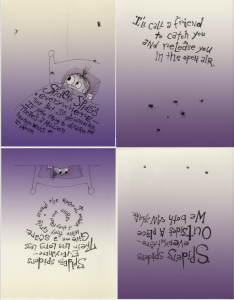
Before moving to NYC to finish my undergrad at Parsons, I had my final art show in Michigan. The title of the show was “Bedtime Stories and Other Disturbances.
In this collection of work, I wanted to illustrate the inherent traumas of childhood. I have vivid memories of being a child, and being constantly afraid. If it wasn’t monsters, it was my parents. The main theme throughout childhood was my lack of control, whether in playdates, emotionally unhinged parents, forced interactions with creepy family members. In all of my pieces, I show this lack of control: the child is powerless, and often in danger–either imagined or imminent .
I used Copic Fineliner pens for all of these pieces. In “Bedtime Story” and “Twins” I also use Moltow Acrylic Markers.
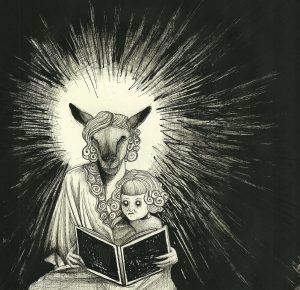
“Bedtime Story”
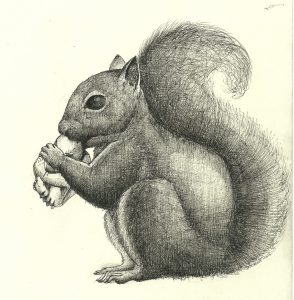
“Babynut”